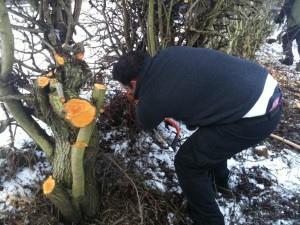It’s a bitterly cold Sunday in February and the only place I’d usually want to be is indoors waiting on my customary Sunday lunch.
Not this weekend – for I was challenged to a FREE hedge laying demonstration at Creswell Crags, with the promise of having a go myself if I was suitably booted.
Armed with little to no knowledge of what I was about to endure - and some sturdy footwear, I headed to Creswell Crags to take up my challenge.
I was greeted by three Burley chaps; Andy (part of Limestone Journeys), Jim – the friendly crags warden, and Tony – a local and willing volunteer.
Andy who is heading the project as part of Limestone Journeys was an almanac of information and full of enthusiasm which certainly helped maintain my interest and geared me up for having a go myself.
Offering a helping hand and a patient manner, I was guided through the traditions of Hedge laying; how it will benefit the local country side and was even given the chance to get stuck in.
Of course I was a little cautious about handling the vast array of tools (being a girl who usually favours glitter over gardener’s gloves) and thought I wouldn’t be much use to the diligent team, but with the appropriate tools and some clear instruction, I was able to make my mark on the landscape – and Andy even expressed how for a first time it ‘wasn’t that bad!’
I spent a good hour and a half with the trio, who were remarkably chipper (no pun intended) despite the snowy conditions, full of useful information and showed a sense of pride in being able to uphold traditions in this way.
It was a fascinating experience and definitely one worth investing your time in –should you have a spare afternoon. Limestone Journeys are constantly on the lookout for willing volunteers.
They are going to be spending five years in the area working alongside the likes of Creswell Crags as part of a funded regeneration project. The demonstrations don’t stop at hedge laying – a fully booked tree felling demo is next on the agenda.
If I can have a go hedge laying – you most certainly can too.
 Why hedge laying?
As part of a biodiversity plan and regeneration project, hedgerows are being restored to provide connecting habitats for local wildlife, as a means of bordering land and helping to maintain traditional working styles across the country. Hedgerows also provide a great source of additional luxuries– bearing fruit to produce sloe gin and quince (although we don’t advise going out and eating what you find in the hedgerows! – leave the picking to the experts).
What’s involved?
Hedge laying uses a long-established technique spanning hundreds of years – with an array of tools (felling axes, mallets, bow saw, bill hooks...) and in this case used the traditional ‘Derbyshire’ style of laying a hedge. (Creswell Crags is on the border of both Nottinghamshire and Derbyshire – with the water through the gorge said to divide the two counties).
Hedge laying involves the process of chopping into the hedge – in this case, Hawthorne (ensuring you don’t chop all the way through) and then laying down the Hawthorne so it’s in contact with another. This will naturally fuse together over time to create a hedge.
TIP! Be prepared to get muddy, watch out for thorns and sturdy footwear is a must.
Limestone Journeys
Limestone Journeys are involved with numerous projects from creating art which promotes heritage, to workshops and training. Find Limestone Journeys on Facebook and track their progress as they continue to restore the surrounding countryside.
For similar demonstrations in the future, contact Creswell Crags.
Why hedge laying?
As part of a biodiversity plan and regeneration project, hedgerows are being restored to provide connecting habitats for local wildlife, as a means of bordering land and helping to maintain traditional working styles across the country. Hedgerows also provide a great source of additional luxuries– bearing fruit to produce sloe gin and quince (although we don’t advise going out and eating what you find in the hedgerows! – leave the picking to the experts).
What’s involved?
Hedge laying uses a long-established technique spanning hundreds of years – with an array of tools (felling axes, mallets, bow saw, bill hooks...) and in this case used the traditional ‘Derbyshire’ style of laying a hedge. (Creswell Crags is on the border of both Nottinghamshire and Derbyshire – with the water through the gorge said to divide the two counties).
Hedge laying involves the process of chopping into the hedge – in this case, Hawthorne (ensuring you don’t chop all the way through) and then laying down the Hawthorne so it’s in contact with another. This will naturally fuse together over time to create a hedge.
TIP! Be prepared to get muddy, watch out for thorns and sturdy footwear is a must.
Limestone Journeys
Limestone Journeys are involved with numerous projects from creating art which promotes heritage, to workshops and training. Find Limestone Journeys on Facebook and track their progress as they continue to restore the surrounding countryside.
For similar demonstrations in the future, contact Creswell Crags.
 Why hedge laying?
As part of a biodiversity plan and regeneration project, hedgerows are being restored to provide connecting habitats for local wildlife, as a means of bordering land and helping to maintain traditional working styles across the country. Hedgerows also provide a great source of additional luxuries– bearing fruit to produce sloe gin and quince (although we don’t advise going out and eating what you find in the hedgerows! – leave the picking to the experts).
What’s involved?
Hedge laying uses a long-established technique spanning hundreds of years – with an array of tools (felling axes, mallets, bow saw, bill hooks...) and in this case used the traditional ‘Derbyshire’ style of laying a hedge. (Creswell Crags is on the border of both Nottinghamshire and Derbyshire – with the water through the gorge said to divide the two counties).
Hedge laying involves the process of chopping into the hedge – in this case, Hawthorne (ensuring you don’t chop all the way through) and then laying down the Hawthorne so it’s in contact with another. This will naturally fuse together over time to create a hedge.
TIP! Be prepared to get muddy, watch out for thorns and sturdy footwear is a must.
Limestone Journeys
Limestone Journeys are involved with numerous projects from creating art which promotes heritage, to workshops and training. Find Limestone Journeys on Facebook and track their progress as they continue to restore the surrounding countryside.
For similar demonstrations in the future, contact Creswell Crags.
Why hedge laying?
As part of a biodiversity plan and regeneration project, hedgerows are being restored to provide connecting habitats for local wildlife, as a means of bordering land and helping to maintain traditional working styles across the country. Hedgerows also provide a great source of additional luxuries– bearing fruit to produce sloe gin and quince (although we don’t advise going out and eating what you find in the hedgerows! – leave the picking to the experts).
What’s involved?
Hedge laying uses a long-established technique spanning hundreds of years – with an array of tools (felling axes, mallets, bow saw, bill hooks...) and in this case used the traditional ‘Derbyshire’ style of laying a hedge. (Creswell Crags is on the border of both Nottinghamshire and Derbyshire – with the water through the gorge said to divide the two counties).
Hedge laying involves the process of chopping into the hedge – in this case, Hawthorne (ensuring you don’t chop all the way through) and then laying down the Hawthorne so it’s in contact with another. This will naturally fuse together over time to create a hedge.
TIP! Be prepared to get muddy, watch out for thorns and sturdy footwear is a must.
Limestone Journeys
Limestone Journeys are involved with numerous projects from creating art which promotes heritage, to workshops and training. Find Limestone Journeys on Facebook and track their progress as they continue to restore the surrounding countryside.
For similar demonstrations in the future, contact Creswell Crags.
“I love conservation work as it allows me to leave my mark on the landscape for years to come” -Andy Cranch.
A hedge layers Dictionary Pleacher – the tree being laid. Bill hook – the tool used to create the cuts into the Hawthorne. (The type used on the day was the traditional Staffordshire bill hook). Stakes – Wood which is hammered into the land to help provide support to the newly created hedge.Related
0 Comments
Comments
Comments are disabled for this post.

 to add an item to your Itinerary basket.
to add an item to your Itinerary basket.









